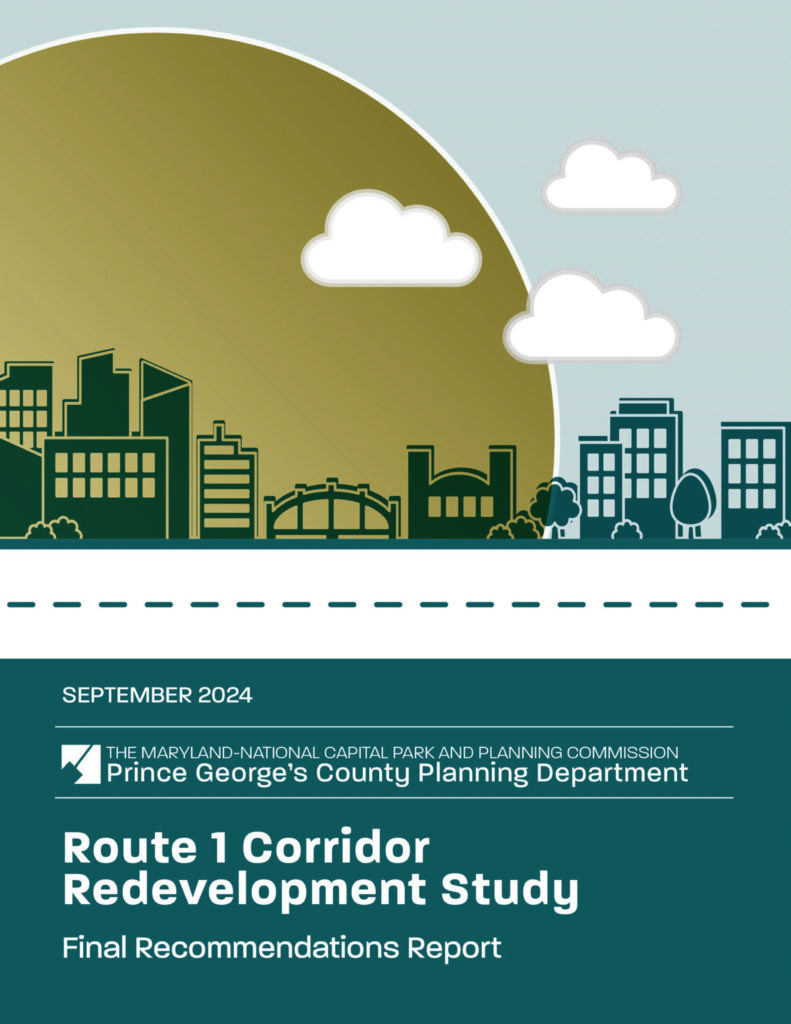Route 1 Land Redevelopment Study
Route 1 Land Redevelopment Study


The Route 1 Corridor Redevelopment Study: Final Recommendations Report has been published and can be viewed here.
Previous Stakeholder Meetings
A Route 1 Land Redevelopment Study Presentation of Findings Community Meeting and briefing was held on Thursday, December 7, 2023. You can view/download a copy of the meeting presentation here.
The Route 1 Land Redevelopment Community Stakeholder Workshop was held on Saturday, June 3, 2023, at the Beltsville Recreation Center. The purpose of the meeting was to provide residents and stakeholders with an overview of the project, share case studies, and receive feedback on findings. View/download the meeting presentation.
Thank you for completing the survey and for your participation in the meetings and workshops!
An Open House and Community Meeting was held on Wednesday, March 15, 2023, to learn more about the Route 1 Land Redevelopment Study. View video of the meeting.
Two meetings were held in December 2022 to engage local stakeholders and create recommendations for future development aligned with the approved Masterplan and Sectional Map Amendment. View or download the PowerPoint presentations from the meetings in English or Spanish.
The Maryland-National Capital Park and Planning Commission (M-NCPPC) agreed with the Smart Growth America consultant team and The Neighborhood Design Center to work on the US Route 1 Redevelopment Study. This project began in June 2022 and will be completed in December 2023.
Stay up-to-date with the project! Sign up here for project updates and other project notifications.
Description
This study looks at the Subregion 1 Plan area along the Route 1 Corridor boundary from Quimby Avenue to Sunnyside Avenue, adjacent to the Beltsville Agricultural Research Center and the immediate surrounding neighborhoods, to develop a strategy that brings in various partners to formulate and consider how to develop sustaining relationships that realize the vision set forth in the Subregion I Plan for this area, with the focus of bringing about coordination among the commercial and industrial uses with the surrounding neighborhoods. This coordinated effort ultimately focuses on improving the visual appearance of the area and ensuring a pedestrian-friendly environment that is a safe and enjoyable place to walk.
Background
The Approved Master Plan and Sectional Map Amendment for Subregion 1 contains a number of policies and strategies aimed at providing a more walkable and urban street form to the US Route 1 corridor. Central to the change in form is the notion of providing frontage on US Route 1. That central concept requires the redevelopment of many sites along the corridor, which has yet to happen. This strategy will look at case studies from across the country that faced similar implementation roadblocks and succeeded. The strategy will discuss, with the experts involved in those cases, the conditions for a successful relationship, and how to ensure all parties buy into the vision and seek to work together to realize it. The strategy will make recommendations regarding successful processes and strategies and how they can be applied to the Route 1 corridor and other areas within Prince George’s County.
The Approved Master Plan and Sectional Map Amendment for Subregion 1 set out a vision for the area, which includes:
- To encourage small-scale, neighborhood-serving, retail uses along the US 1 Corridor to meet gaps in the marketplace.
- To provide high-quality mixed-use development along US 1.
- To provide a pedestrian-friendly environment that is a safe and enjoyable place to walk.
- To develop design standards and guidelines for achieving high-quality development and improving the form and character of development along the corridor.
- To support a quality urban design framework.
- To eliminate substandard, marginal uses and properties, along the US 1 Corridor that need major structural repair and/or promote an unsafe, low-quality setting.
Goals
- To provide an assessment of the available tools from each of the case studies and make recommendations for The Approved Master Plan and Sectional Map Amendment for Subregion 1 . These tools may include, but not be limited to, those which could lead to land assembly or those related to land value capture. Land purchase and assembly should not be the only solutions. The assessment should evaluate the tools, providing a comprehensive list of positive and negative aspects for each.
- To identify any tools that could also be applied to other areas in the county facing a similar situation,
- To evaluate the effectiveness of incentives—both regulatory and financial—to property owners and potential corridor businesses, including those available for business start-ups, facility expansions, job creation, and equipment purchases—to facilitate the region’s job growth and maximize the commercial tax base.
- To provide a financial analysis of the study area, taking into account the land value and potential for redevelopment,
- To make recommendations on funding and the roles of government agencies and partners,
- To encourage greater coordinated relationships among commercial and industrial land uses with surrounding neighborhoods.
- To establish and maintain dialogue and close collaboration between the county and existing property owners along the US 1 Corridor in preparation for long-term redevelopment.
Contact us
Vanessa C. Akins
Special Program Management Coordinator
PHONE: 301-952-3134
EMAIL: vanessa.akins@ppd.mncppc.org

